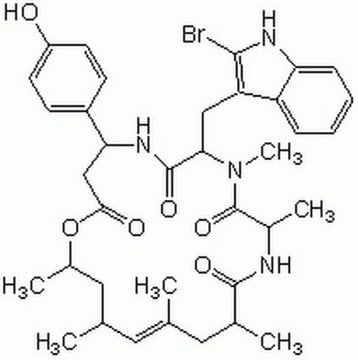428021
Latrunculin A
from Latrunculia magnifica, ≥95% (HPLC), solid, actin polymerization inhibitor, Calbiochem
Synonyme(s) :
Latrunculin A, Latrunculia magnifica
About This Item
Produits recommandés
product name
Latrunculin A, Latrunculia magnifica, Latrunculin A, CAS 76343-93-6, is a cell-permeable marine toxin that disrupts microfilament organization in cultured cells by the formation of a 1:1 complex with monomeric G-actin (KD = 200 nM).
Niveau de qualité
Pureté
≥95% (HPLC)
Forme
solid
Fabricant/nom de marque
Calbiochem®
Conditions de stockage
OK to freeze
protect from light
Couleur
white
Solubilité
DMSO: 25 mg/mL
Conditions d'expédition
ambient
Température de stockage
−20°C
InChI
1S/C22H31NO5S/c1-15-7-5-3-4-6-8-16(2)11-20(24)27-18-12-17(10-9-15)28-22(26,13-18)19-14-29-21(25)23-19/h3-5,7,11,15,17-19,26H,6,8-10,12-14H2,1-2H3,(H,23,25)/b4-3+,7-5-,16-11-/t15-,17-,18-,19+,22-/m1/s1
Clé InChI
DDVBPZROPPMBLW-IZGXTMSKSA-N
Description générale
Actions biochimiques/physiologiques
G-actin
Conditionnement
Avertissement
Reconstitution
Autres remarques
Spector, I., et al. 1989. Cell Motil. Cytoskeleton 13, 127.
Coue, M., et al. 1987. FEBS Lett. 213, 316.
Schatten, G., et al. 1986. Exp. Cell Res. 166, 191.
Spector, I., et al. 1983. Science 219, 493.
Informations légales
Code de la classe de stockage
11 - Combustible Solids
Classe de danger pour l'eau (WGK)
WGK 3
Point d'éclair (°F)
Not applicable
Point d'éclair (°C)
Not applicable
Certificats d'analyse (COA)
Recherchez un Certificats d'analyse (COA) en saisissant le numéro de lot du produit. Les numéros de lot figurent sur l'étiquette du produit après les mots "Lot" ou "Batch".
Déjà en possession de ce produit ?
Retrouvez la documentation relative aux produits que vous avez récemment achetés dans la Bibliothèque de documents.
Les clients ont également consulté
Notre équipe de scientifiques dispose d'une expérience dans tous les secteurs de la recherche, notamment en sciences de la vie, science des matériaux, synthèse chimique, chromatographie, analyse et dans de nombreux autres domaines..
Contacter notre Service technique
















